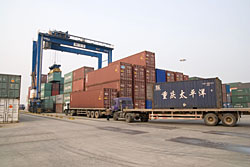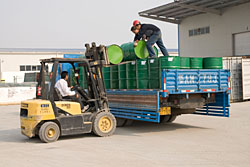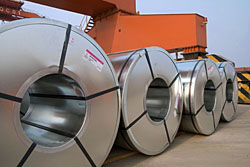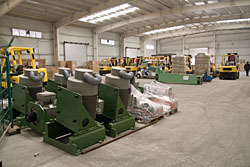Major Revenue Segments of the Group
Overall business environment
The principal activities of CIL are investment in and the development, operation and management of container and other ports (including the WIT Port ( 武漢陽邏港), the Multi-Purpose Port ( 通用港口) and the Hannan Port ( 漢南港), all located in the Yangtze River Basin in Hubei Province, the PRC), and the provision of port related integrated logistics, leasing of port-related warehouses, supply chain management, trading services and other services.
CIL recorded revenue of HK$396,529,000 in 2024, representing an increase of 9.8% compared with the previous year; total profit of HK$12,895,000, representing a decrease of 6.5% over the same period last year. Container throughput amounted to 900,342 TEUs, representing an increase of 200 TEUs over the same period last year. As of the end of 2024, the total net assets amounted to HK$814,289,000, with a debt-to-asset ratio of 37.7%, and the average earnings per share were HK$0.74.
As the core asset of CIL, the WIT Port serves as a central hub in the middle reaches of the Yangtze River and a strategic pivot for the “Port Economic Belt” of Hubei Province, and is transitioning from a traditional port to an “intelligent + industrial” comprehensive hub, benefiting from both policy support and geographic positioning. According to the data from the China Port & Harbors Association, in 2024, the comprehensive business environment evaluation of the WIT Port ranked 3rd among China’s inland river ports, climbing two positions compared with 2023.
In 2024, China completed a port cargo throughput of 17.6 billion tones, representing an increase of 3.7% over the same period last year. Among them, the cargo throughput of coastal ports was 11.5 billion tons, representing an increase of 3.4%; the throughput of foreign trade goods was 5.4 billion tons, representing an increase of 6.9%; and the throughput of domestic trade goods was 12.2 billion tons, representing an increase of 4%. The container throughput was 332 million TEUs, representing an increase of 7%.
Since Hubei Port became the immediate holding company of the Company in January 2022, the integration of phase I, II and III terminals of Yangluo Port has been completed so as to further optimize port logistics resources, all of which were conducive to the synergy and development of the Group’s port business.
The Group has vigorously developed new projects and new source of goods. The whole-vehicle container transportation business has been introduced. To actively develop new source of goods, leveraging on the opportunity of domestic vehicles to enter the international market, the Group has designed optimal packing solutions for different whole-vehicle container transportation so as to open up export channels for new energy vehicles, and form a stable source of goods for export projects. In 2024, 1,869 vehicles were packed with a total of 1,367 TEUs. Macheng stone market has been further developed. According to the unified deployment of the Group, a special team has been established to develop the Macheng stone market. The team takes advantage of the existing direct shipments to Japan and South Korea at Yangluo Port and successfully guides the return of some customers who export stone to Busan, Korea, thus securing a regular source of goods for export per week. The steel product loading and unloading business has been further developed. The Group has reached cooperation with Hubei Daming, Wuhan Zhuolixin ( 武漢卓立信), Hanyang Steel Mill ( 漢陽鋼廠) and other companies on steel coil loading and unloading business, which is operated in the free time of port berths and has greatly improved the utilization rate of berths. The Group continued to guarantee the services for direct shipping vessels. At present, Wuhan Datong ( 武漢大通) has put a total of 4 ships into operation on the international direct route of “Wuhan-Japan, South Korea and Russia”, forming a regular export schedule of 2-3 shipments per week. As the designated port for operations of international direct shipping vessels, Yangluo Port continued to offer “priority berthing, efficient and safe” loading and unloading services for international direct shipping vessels as a way to provide “logistics” support for the development of international direct shipping vessel business.
The WIT Port and the Multi-Purpose Port
The WIT Port and the Multi-Purpose Port are located in the Yangluo Economic Development Zone, Wuhan, Hubei Province, the PRC, which are the core ports of maritime centre along middle reaches of the Yangtze River.
Wuhan has a solid and developed industrial base, and is where various major industrial operators have commenced operations in, including operators of automobile and parts, petrochemical products, steel, grain, wood, textile, machinery and equipment as well as construction material businesses. They have been and will continue to be the major suppliers of gateway cargo containers transportation service in the WIT Port.
There are many ports opened. Due to the channel passage capacity limitations along the upstream regions of the Yangtze River, large ships are precluded from navigating directly between those areas and Shanghai. The trans-shipment service provided by the WIT Port offers a more economical alternative for customers in these areas, namely the trans-shipment of container cargoes to Shanghai or direct shipping overseas upon amalgamation at Yangluo Port. The economic hinterlands which are serviced by the WIT Port include Hunan, Guizhou, Chongqing, Sichuan, Shanxi, Henan, Hubei and Shaanxi Provinces. In 2023, the regional routes of “Wuhan-Huanggang” and “Wuhan-Ezhou”, rail-water route of “Macheng-Wuhan-Shanghai-Ethiopia”, rail-water route of “Yingcheng-Wuhan-Shanghai/Guangdong”, river-sea route of “Russia-Shanghai-Yangluo Port” and the direct shipping route of “Yangluo Port to Kailai Port in Vietnam” were newly opened. The direct shipping route of “Yangluo Port to Kailai Port in Vietnam” is the fourth international direct shipping route opened by Wuhan. It is the most convenient transportation channel between Hubei and ASEAN region, which will help promote business and trade between Hubei and ASEAN, and help Hubei to build a modern comprehensive traffic and transportation system leading central China, radiating the whole country, and reaching the whole world. In addition, two new ships were put into operation on the international direct route of “Wuhan-Japan, South Korea and Russia”, forming a regular export schedule of two shipments per week. Enriching shipping routes and increasing the number of shipments are beneficial to the further enhancement of the turnover rates of import and export goods in Hubei, marking the further enhancement of the position of Wuhan International Port as a hub and taking the construction of the Wuhan maritime centre along the middle reaches of the Yangtze River to a new stage.
The Group has expanded and improved the scope and level of port services. Water-gate inspection points have been established. In order to meet the customer demand for container inspection services and reduce customer friction, upon communicating with Wuhan Xinsanli ( 武漢鑫三利) and Wuhan Jiujia ( 武漢久嘉), two container repair service companies, and through public bidding, the Group has set up container inspection service points at water-gates to further reduce the turnover of empty containers in the field, and thus lower operating costs and improve customer satisfaction. The source of empty containers at ports has been enriched. The Group has newly signed 3 container management customers, namely Jiangsu Changyue ( 江蘇長越), Russian Railway Jiangsu Xinhelu Shipping Co., Ltd. ( 俄鐵江蘇新合路航運有限公司), and Summit Shipping Co., Ltd. ( 薩米特航運有限公司), to further enrich the source of empty containers at ports, which is expected to bring 340-600 TEUs of new containers per month. The coverage of port container management has been extended. The Group has signed the Regional Container Management Agreement with CMA CGM Group to extend our port container management service to Yichang, Huangshi and Jiangxi. By doing this, the Group has further extended the coverage of port container management. We have communicated with various agent customers to assemble and disassemble containers outside the port in our CFS to ensure the stable growth of CFS business. The CFS of Yangluo Port and Zhonggang Logistics ( 中港物流) have shared out the work and cooperated with each other on assembling and disassembling business as a way to reasonably allocate existing resources, and enhance market competitiveness.
The Group has also developed port related services, including agency and integrated logistics services to expand its revenue
sources. Such agency and integrated logistics services include bonded warehousing, customs clearance, break bulk and
distribution at the WIT Port.
The Hannan Port
The Hannan Port is located along the Yangtze River in economic and technological development zone, Wuhan, adjacent to the Shanghai-Chengdu Expressway, Beijing-Zhuhai Expressway and is within 80 kilometers of the Beijing-Guangzhou and Beijing-Kowloon rail link.
Wuhan, the provincial capital of Hubei, is an important transport hub in the PRC. In terms of riverway traffic, Wuhan is linked through the Yangtze River with eight provinces (namely Jiangsu, Anhui, Hubei, Sichuan, Jiangxi, Hunan, Yunnan and Guizhou) and Shanghai. Given the important role of Wuhan in the development of the Yangtze River Economic Belt, the Directors consider that it is in the interests of the Group to make further investments in its port businesses in the Wuhan area.
The Hannan Port creates synergies between the WIT Port and the Hannan Port, particularly because the management team of the WIT Port has extensive experience in the construction, development and management of ports in the PRC. Being the feeder port of the WIT Port, the Hannan Port can increase the throughput capacity of the WIT Port to satisfy the demand for logistics services in Wuhan. The WIT Port, together with the Hannan Port, can provide more cost effective solutions to the Group’s customers. The Hannan Port will be developed into a multi-purpose service platform in several phases, providing terminal, warehousing and logistics services and other services including RORO (Roll on Roll off), bulk cargo transportation and storage, automobile spare parts processing, as well as logistics services.
The Group is committed to transforming the Hannan Port into the largest port in Central China, integrating supply chain design and operations, waterway logistics distribution, O2O automotive transactions, multi-modal transportation, logistics finance, distribution and delivery, customs brokerage, and so on. The port will primarily focus on automotive logistics and transactions, complemented by general cargo and container services, blending specialization with comprehensive services. It aims to become a regional economic hub and a key logistics node, establishing itself as the most important logistics center in the southwest of Wuhan, a crucial automotive transaction center in the “Wuhan Metropolitan Area”, and a significant modern, comprehensive logistics service base.
The Hanjiang Logistics Centre
The Group owned the Hanjiang logistics centre adjacent to the Shayang Port. It comprises 7 blocks of warehouses and an ancillary office building and it is intended to be held as investment property for generating rental income.
Tongshang Supply Chain
Leveraging the Group’s extensive experience in the operation and management of various ports and terminals located within the Yangtze River Basin in Hubei Province, coupled with its solid customer and supplier network cultivated during its many years of business operation, Tongshang Supply Chain Management (Wuhan) Co., Ltd.* (通商供應鏈管理(武漢)有限公司) (“Tongshang Supply Chain”) serves as the principal supply chain service provider and trader for up-stream suppliers and down-stream customers through the supply chain management and trading business of the Group. The development of supply chain management and trading business will enable the Group to establish deeper connections with both supply and demand sides of the supply chain, positioning in various business such as trading, logistics, storage and delivery of bulk grain commodities domestically and in Southeast Asia and enhance efficiency of integrated services. At the same time, it will enable the Group to consolidate and optimise flows of commodities, capital and information for the supply chain, which will facilitate trading among enterprises, reduce costs and strengthen competitiveness of the Group, striving to build a bulk grain trading and distribution centre which centered around Wuhan, Hubei and relying on the port.
Leveraging the Group’s resources in the operation and management of various ports and terminals located within the Yangtze River Basin in Hubei Province, coupled with its solid customer and supplier network cultivated during its many years of business operation, Tongshang Supply Chain has integrated and optimized the information flow, logistics and capital flow of upstream and downstream customers through its supply chain business to obtain a more obvious competitive advantage with stable and deeper cooperative relationships. Relying on the unique geographical location and the function as a grain port of the Yangluo Port as well as the strong hinterland economy, Tongshang Supply Chain focuses on the livelihood fields such as grain and agricultural and sideline products, and provides customers with integrated comprehensive logistics services such as logistics, warehousing, distribution, and supply chain finance. It vigorously develops the hub economy, and strives to build a modern port-surrounding supply chain system featured “port + trading + warehousing + logistics” to promote closer integration of port, industry and city. Tongshang Supply Chain aims to build a bulk grain commodity trading center with Yangluo Port as the core, contributing the port strength to “foreign to domestic grain transportation” and “north to south grain transportation”.
Operating results
Revenue
| Year ended 31 December | ||||||
|
2024 |
2023 |
Increase/(Decrease) |
|||
|
HK$’000 |
% |
HK$’000 |
% |
HK$’000 |
% |
|
|
|
|
|
|
|
Revenue from contracts with customers within scope of IFRS 15 |
|
|
|
|
|
|
Terminal service |
110,647 |
29.7 |
111,183 |
30.8 |
(536) |
(0.5) |
Container handling, storage |
37,135 |
9.4 |
37,161 |
10.3 |
(26) |
(0.1) |
General and bulk cargoes handling |
1,926 |
0.5 |
3,698 |
1.0 |
(1,772) |
(47.9) |
|
149,708 |
37.8 |
152,042 |
42.1 |
(2,334) |
(1.5) |
Integrated logistics service |
49,990 |
12.6 |
38,230 |
10.6 |
11,760 |
30.8 |
Supply chain management and |
184,797 |
46.6 |
158,281 |
43.8 |
26,516 |
16.8 |
384,495 |
97.0 |
348,553 |
96.5 |
35,942 |
10.3 |
|
| Revenue from other sources | ||||||
| Property business | 12,034 |
3.0 |
12,748 |
3.5 |
(714) |
(5.6) |
396,529 |
100.0 |
361,301 |
100.0 |
35,228 |
9.8 |
|
For the year ended 31 December 2024, the Group’s revenue amounted to HK$396,529,000 (2023: HK$361,301,000), representing an increase of approximately 9.8% as compared to 2023. The increase in revenue are mainly due to the offsetting effects of:
(i) the decrease in revenue from terminal and related business of 1.5% to HK$149,708,000 (2023: HK$152,042,000), mainly due to the disposal of Zhongxiang City Port Co. as its primary business is terminal and related business and the decrease of trans-shipment cargoes drove the decrease in revenue from the terminal service business;
(ii) the increase of Integrated logistics service revenue increased by 30.8% to HK$49,990,000 (2023: HK$38,230,000), primarily due to the increase in business volume from the WIT Port;
(iii) the increase in revenue of 16.8% to HK$184,797,000 (2023: HK$158,281,000) from the supply chain management and trading business, mainly due to the continued strong demand for the rice and broken rice trading business.
Terminal service
Container throughput
| Year ended 31 December | ||||||
|
2024 |
2023 |
Increase/(Decrease) |
|||
|
TEUs |
% |
TEUs |
% |
TEUs |
% |
|
|
|
|
|
|
|
Gateway cargoes |
366,412 |
40.7 |
320,905 |
35.7 |
45,507 |
14.2 |
Trans-shipment cargoes |
533,930 |
59.3 |
579,237 |
64.3 |
(45,307) |
(7.8) |
|
900,342 |
100.0 |
900,142 |
100.0 |
200 |
0.1 |
Provision of terminal service, container handling, storage and other service, general and bulk cargoes handling service at the
WIT Port is one of the Group’s principal business. Total throughput achieved by the WIT Port for the year ended 31 December
2024 increased by approximately 0.1% to 900,342 TEUs (2023: 900,142 TEUs). Among them, the shares of local and
trans-shipment cargoes were about 40.7% and 59.3% respectively. The gateway cargoes throughput increased by
approximately 14.2% to 366,412 TEUs (2023: 320,905 TEUs) and the trans-shipment cargoes throughput decreased by
approximately 7.8% to 533,930 TEUs (2023: 579,237 TEUs).
The increase in overall container throughput was mainly attributable to a 14.2% increase in gateway cargo containers, which offset the decrease in trans-shipment containers. The increase in gateway cargo containers was mainly due to the completion of acquisition of the controlling interests of the Group by Hubei Port since January 2022 and the successful integration of Phase I, Phase II and Phase III of Yangluo Port area, resulting in the cessation of price cutting competition and exertion of synergetic effect. Besides, a new trans-shipment route between Yangluo and Huanggang region and Ezhou intercity trans-shipment route were added during the year ended 2023.
Market share
The Group’s market share of container throughput in Wuhan for the year ended 31 December 2024 was approximately 25.7% (2023: 32%) based on a total of 3,500,000 TEUs (2023: 2,790,000 TEUs) handled for the whole of Wuhan Ports in 2024.

Integrated logistics service
The integrated logistics service business of the Group provides agency and logistics services mainly at the WIT Port and the Hannan Port, including provision of freight forwarding, customs clearance, transportation of containers and logistics management services. Revenue generated from the integrated logistics service business for the year ended 31 December 2024 increase by 30.8% to HK$49,990,000 (2023: HK$38,230,000). The relevant revenue accounted for approximately 12.6% of the Group’s total revenue for the year ended 31 December 2024 (2023: 10.6%).
The increase in revenue was mainly attributable to the increase in business volume from the WIT Port for the year ended 2024.

Supply chain management and trading business
The revenue of the Group’s supply chain management and trading business increased by 16.8% to HK$184,797,000 (2023: HK$158,281,000) which accounted for approximately 46.6% of the Group’s total revenue for the year ended 31 December 2024 (2023: 43.8%).
The increase mainly due to the continued strong demand for the rice and broken rice trading business for the year ended 2024 as well as the introduction of paddy rice products in the second half of 2024.
Property business
Revenue for the Group’s property business was mainly generated from the port and warehouse leasing business of the Hannan Port, Wuhan which owns investment properties of leasehold lands, berth, commercial buildings and pontoon, as well as the leasing of a stacking yard and certain warehouses at the WIT Port during the year ended 31 December 2024. The port and warehouse leasing income for property business decreased by 5.6% to HK$12,034,000 (2023: HK$12,748,000) which accounted for approximately 3.0% of the Group’s total revenue for the year ended 31 December 2024 (2023: 3.5%).
The decrease was mainly due to the decrease in revenue from the leases for the stacking yard at the WIT Port and the Hannan Port resulted from the decrease in rental area.
Gross profit and gross profit margin
For the year ended 31 December 2024, gross profit decreased by 20.7% to HK$61,613,000 (2023: HK$77,653,000) and
gross profit margin was 15.5% (2023: 21.5%). The decrease in gross profit and gross profit margin is primarily due to the
increase in revenue from supply chain management and trading business with relatively lower gross profit margins, as well as
the increase in direct labor costs for the year ended 2024 and a write down of inventories of approximately HK$2,257,000.

Other income
Other income for the year ended 31 December 2024 increased by approximately 71.5% to HK$37,934,000 (2023: HK$22,117,000). The increase was mainly attributable to (i) the disposal of equity interest in a subsidiary by the Group with a gain of approximately HK$4,901,000; and (ii) the Group has received a compensation income in the amount of approximately HK$18,910,000 in relation to a historic construction contract.
Net change in fair value of investment properties
The Group holds certain investment properties, including (i) the port and warehouse in the Hannan Port; (ii) the logistics centre adjacent to the Shayang Port; and (iii) a stacking yard and certain warehouses at the WIT Port. The Group’s investment properties are revalued at the end of the reporting period on an open market value basis by an independent property valuer. Changes in fair value arising from such revaluations are accounted for as “change in fair value of investment properties” through the consolidated statement of profit or loss and other comprehensive income. For the year ended 31 December 2024, the Group recorded a fair value loss in the value of investment properties of HK$1,734,000 (2023: a fair value loss in the value of investment properties of HK$993,000).
The increase in fair value loss of investment properties is mainly due to a moderation in the decrease in market rent of the warehouse properties in the logistics centre adjacent to the Shayang Port as compared to year ended 31 December 2023.
Profit attributable to owners of the Company for the year
Profit attributable to owners of the Company for the year decreased by HK$2,666,000 or approximately 17.4% to HK$12,694,000 (2023: HK$15,360,000). The decrease in profit attributable to owners of the Company was mainly driven by the offsetting effects of (i) the decrease in gross profit of approximately HK$16,040,000; (ii) the increase in a fair value loss from investment properties of approximately HK$741,000 as compared to the corresponding year; (iii) the increase in other income of approximately HK$15,817,000; (iv) the decrease in net finance costs of approximately HK$4,373,000; and (v) the increase in income tax expense of approximately HK$5,520,000 due to a one-off non-recurring gain on disposal of equity interest in a subsidiary and the deferred tax assets arising from the fair value loss on investment properties and the increase in expected credit loss of receivables.
Earnings per share (basic and diluted) attributable to owners of the Company for the year ended 31 December 2024
was HK0.74 cents (2023: HK0.89 cents), representing a decrease of 16.9% as compared with that for the year ended 31
December 2023.
